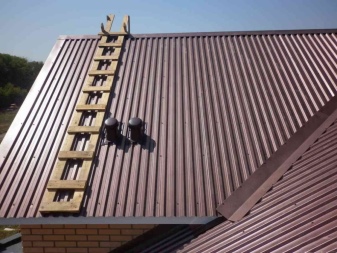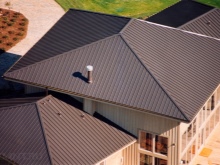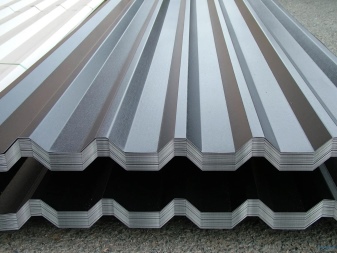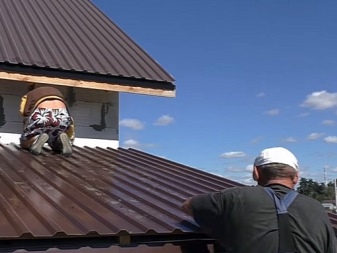Dimensions of roof sheeting

Profiled sheet is the most suitable roofing material in terms of installation speed and quality. Thanks to galvanizing and painting, it can last 20-30 years before the roof does start to rust.


Suitable sizes
The optimal dimensions of the profiled sheet for the roof are the length and width of the sheet, its thickness. Then the consumer pays attention to the texture (for example, waves), which allows precipitation (rain, melt water from snow or hail) not to spread out to the sides, but to flow down smoothly.
Technical and operating conditions during the manufacture, transportation, installation and maintenance of the already installed roof are regulated on the basis of GOST №24045-1994.


Lenght and width
As this parameter - full and useful length and width of the corrugated board. Useful dimensions - width and length of the sheet after forming: shaped waves, thanks to which the sheet steel has received the definition of "profiled sheet", do not affect the actual ("stretched") area of the building material, but lead to a decrease in length.
The professional sheet is not in vain made wavy: ease of installation, resistance to longitudinal leakage of water from precipitation allow you to evenly lay this building material as the top layer of a roofing cake, protect it from displacement in a hurricane, bending the sheet by a strong wind, blowing in the cracks that would form in the places of these lines.


Rolled length - the actual dimensions of conventional sheet steel that have not yet been exposed to the plate bending conveyor. This is an indicator of the actual consumption of steel, zinc and paint on metal. Neither the consumption of metals and paint, nor the volume in the warehouse occupied by a stack of ordinary or profiled sheets depends on what the length and width are - rolling and useful. The profiled sheet is saved - in terms of the occupied area of the roof - only with real installation.
Laying with an overlap of one or one and a half waves allows you to reduce the covered area by a few more percent.
In reality, the actual saving on the profiled sheet is the opposite: the overlap removes part of the original effective width of the profiled sheet.


Full length and width - the distance between the edges of the sheet. The length of the profiled sheet ranges from 3 to 12 m, the width - from 0.8 to 1.8 m. By pre-order, the length of the profiled sheet is made in lengths from 2 to 15 m - for situations where a shorter or longer profiled sheet would be lifted onto the roof lathing difficult. The useful length and width are the final dimensions remaining after subtracting the amount of overlap.
The length of the sheet is selected in such a way that it corresponds to the length of the slope (rafters) and the distance that the roof hangs outside the outer perimeter of the walls. The latter includes an additional 20-40 cm. When using shorter sheets, the material is laid with an overlap, which reduces the quality of the waterproofing of the battens and rafters. The overlap cannot be more than one wave.


Thickness and height
The steel sheet is selected in thickness equal to 0.6-1 mm. Thinner steel cannot be used - it will be punctured under the influence of hail, snow or as a result of people walking on the roof. Thin sheet profiled steel is easily damaged even at the installation stage - do not save on thickness. A temporary, but worst solution is to fasten at once 2-3 sheets with a thickness of 0.4-0.6 mm, but such a roof will not be considered the most stable, since the layers (sheets) are slightly displaced relative to each other, no matter how reliably they are fixed.Self-tapping screws with gaskets, piercing holes in them, will stretch these holes, making them oval in shape, as a result, the roof will begin to "walk".
The height of the profiled sheet varies in the range of 8-75 mm. The difference between the upper and lower edges of the half-wave is formed at the stage of forming the profiled sheet. Wall profiled sheets used for the construction of fences are suitable for almost any work - even internal ones, for example, when decorating a garage: for them, this difference does not go beyond 1 cm.For the roof, the wave height should be at least 2 cm.
At the junction on the profiled roofing sheet, a special groove is made for draining excess water.


Payment
Ideally, the useful length of the profiled sheet is equal to its final length. For a more accurate calculation, the roof area is measured and calculated. Then the obtained values - including the length and width of the roof to be re-covered (or "from scratch") are divided by the real useful length and width of the profiled sheet. In this case, overlap is taken into account - it is impossible to put sheets to each other, strictly along the edges.
As an example - the real number of copies of the profiled sheet, spent on a reliable shelter of a wooden attic from rain, snow, hail and wind, for a pitched roof. Let's say the width of the roof slope is 12 m. As the correction data, a multiplier of 1.1 is taken (+ 10% to the width of the sheet), taking it into account will take into account the formation of a certain amount of waste generated when cutting sheets. With this amendment, the width of the roof slope would be 13.2 m.


To finally determine the number of copies of the profiled sheet, the resulting value is divided by a useful width indicator. If a professional sheet with the NS-35 marking is used - 1 m wide - then, taking into account rounding up, at least 14 sheets will be required.
To determine the number of profiled sheets according to their total square, we multiply the number of sheets by the length and width of the sheet.
For example, 6-meter long sheets of the NS-35 profile have a width of a meter and a quarter. In this case, it is 105 m2.

If the roof is gable, then the calculation is carried out for each slope separately. With the same slopes, this will not be difficult to calculate. A roof with slopes at an angle different to the horizon will slightly complicate the calculation - moldings and squares are calculated separately for each of the slopes.
If you don't have time to do a standard calculation yourself, you can use online calculators, the script of which includes calculations for the parameters of a roof of any configuration. It is better to calculate profiled sheets for 4-pitched and multi-level roofs with arbitrary arrangement of sheets using a script on the site than to calculate from scratch yourself.



What to consider when choosing sheets?
First of all, the thickness of the metal for the roof should be maximum. It is one of the key characteristics on which the service life and strength of the roof depends. Ideally, it is millimeter steel that effectively resists deflection. For garage construction, instead of profiled sheets, simple sheet steel with a thickness of 2-3 mm was chosen, which allowed an all-steel garage to stand for more than one decade.
According to SNiP, a thickness of 0.6 mm can be chosen for private construction on a territory that is reliably fenced off from strangers. In the case of apartment buildings and factory construction, 1 mm steel is used.
A large thickness is used on the roof with a lathing step commensurate in terms of the overall strength of the entire structure - the step of rafter and lathing boards / beams should not exceed 60 cm, which means that there is no point in using steel thicker than 1 mm.



Wave height will play an important role in the strength of the roof. Although this is not a panacea for overloading, for example, from a large number of people who went to the roof to service the roof, waves of 2 cm or more are a temporary solution. The fact is that the profiled sheet bends more difficult, its relief partially compensates for the steel bending.However, the prohibitive load, for example, from a heavyweight worker who put on boots with very solid heels and walked casually on the roof, will simply wash the waves.
A leaf length of 4 m is suitable for a slope whose width is less than this length. The calculation must be made taking into account the steel ridge, each side strip of which will partially reduce the main width of the slope covered by the profiled sheet. Up to 30 cm can go under the ridge - the remainder is important in case the lower edge of the profiled sheet hangs over the armopoyas with the Mauerlat, partially protecting the walls of the house from slanting rains. For slopes up to 6 m, 6-meter sheets are suitable. For slopes differing in significant width - up to 12 m - sheets of similar length are suitable; the longer the sheet, the more laborious it is to install. The solution, providing for the installation of sheets with a fit to the width of the slope, allows you to get rid of horizontal seams - the entire strip is a single whole.


Type of covering of corrugated board
Plastic coated decking looks promising in terms of durability. If the composition resists the negative effects of excess heat and ultraviolet radiation, and also does not crack in the cold, then such sheets will last a long time - up to 40 years.
Simple roofing iron, which was a "calm steel", deserved special attention. - stewed sheet metal, capable of serving not 3-5, but up to 30 years when the protective layer peels off.
Its essence is that excess gases, including oxygen residues, were removed from the steel kept for a long time in the molten state, and such steel had a slightly higher density, much higher strength and corrosion resistance.


The technologies and standards that make it possible to produce "calm" steel have proven to be very energy-intensive. GOST standards for casting and rolling steel have changed along with technology. Steel production has accelerated - as a result, its durability has suffered. Considering this, the coating of steel structures, including the profiled sheet, is selected so that it does not fade for a long time and does not wear out before the bearing material from which the profiled sheet is made is exposed. It is useful to inspect the roof every six months or a year for peeling of the protective coating - and if you suspect looseness, fading, renew it using a primer-enamel for rust and polymer (synthetic) paint.
The thickness of each coating layer is at least 30 microns: a thinner coating will peel off much faster, and the steel will rust in a few days after the protective layer is completely peeled off. Some craftsmen use galvanized profiled sheet, but zinc is easily corroded by acid, the remains of which (sulfurous, nitrogenous, coal) are always present in urban precipitation (rain). For the roof, zinc coating - although it is not afraid of water as such - is not used.


Companies supplying ready-made profiled sheet for roofing work announce the recommended service life - 15-40 years. The minimum service life of the roof in case of careless use of the roof - for example, falling of hand tools leading to scratches of the coating, keeping forgotten and unnecessary things (especially metal) on the roof - will be reduced to just a few years. They do not undertake to guarantee a longer "life" of the profiled sheet, no matter how strong and high-quality steel is, it cannot "live" 100 or more years.
The steel profiled sheet, in addition to its weight, can withstand the weight of snow, people passing along the roof during its maintenance (and scheduled repairs), as well as tools laid out in the place of work. At the same time, the roof should be solid, capable of holding back all these influences at once.















The comment was sent successfully.